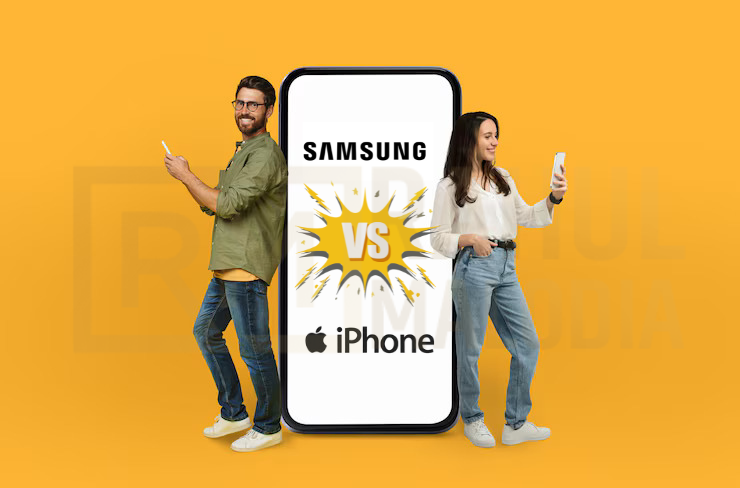
Samsung vs iPhone: A 2025 Comparison of Marketing Strategies & Brand Positioning
Let’s be honest, whenever someone asks, “Which phone is better, Samsung or iPhone?” The debate never really ends. In 2025, this rivalry is no longer about megapixels or battery backup alone. It has transformed into something much bigger. It’s a fight between two ways of living, two different approaches to technology, and two powerful brand identities.
And in India, where smartphones have become the heartbeat of both personal and professional life, this debate feels even more alive. Whether you’re an entrepreneur running your entire business from your phone, a professional juggling between calls and emails, or simply someone who enjoys capturing memories, the choice between Samsung and iPhone goes far beyond the device itself. It’s about identity, convenience, and the story you want your technology to tell about you.
So let’s dive into how Apple and Samsung are shaping the smartphone battle in 2025, not through processors and displays, but through marketing strategies, brand positioning, and consumer psychology.
Apple: The Emotion-Driven Minimalist That Sells a Feeling
Apple has never really sold just products. What they’ve sold is emotion. Back in the early 2000s, Steve Jobs introduced the iPod not as a music device, but as “1,000 songs in your pocket.” That legacy continues even stronger today with the iPhone 16 series.
Look at any Apple advertisement in 2025. It rarely talks about the number of megapixels or the processor speed. Instead, it shows a father FaceTiming his daughter from another city, a student editing a documentary on iMovie, or a mother capturing her child’s first school performance in cinematic mode. Apple’s marketing doesn’t scream specs. It whispers feelings.
And this emotional branding works brilliantly. According to Counterpoint Research, Apple now controls over 20% of the global smartphone market by revenue, even though it sells fewer units than Samsung. Why? Because people don’t just buy iPhones. They buy the experience of belonging to something premium, seamless, and aspirational.
In India too, Apple is slowly breaking the old myth that “iPhones are only for the rich.” With manufacturing moving to Tamil Nadu and Karnataka under the Make in India initiative, iPhones have become more affordable, helping Apple capture a larger chunk of India’s premium smartphone market, growing over 30% in sales year-on-year by 2025.
For Apple, the product is important. But emotion is everything.
Samsung: Loud, Bold, and Feature-First
Now let’s switch gears. If Apple is a storyteller, Samsung is a showman. And it shows.
In 2025, Samsung is still the world’s largest smartphone manufacturer by volume, with around 20% of the global market share. Their strength lies in innovation, variety, and confidence. From foldable phones like the Galaxy Z Fold6 to AI-driven cameras in the Galaxy S25 Ultra that can capture 200MP shots, Samsung doesn’t hesitate to put its tech front and center.
Their ads are louder, sharper, and often directly focus on what their phones can do. You’ll see campaigns highlighting how you can stream games on a Galaxy device for hours without overheating, or how the new AMOLED 3X display saves power while showing colors that pop. For entrepreneurs and professionals, Samsung devices often serve as portable workstations. With DeX, you can turn your phone into a desktop by simply connecting it to a monitor.
Samsung’s greatest strength, however, is its inclusivity. Unlike Apple, which focuses on premium users, Samsung has something for everyone, from the Galaxy A75 5G priced for middle-class families in tier-2 cities, to the Galaxy S25 Ultra for CEOs who want the best. This wide reach makes Samsung the true “people’s brand.”
In India, Samsung continues to dominate the mid-range market. Walk into any small-town mobile store and you’ll see Samsung ads in Hindi, Tamil, Bengali, or Marathi. That’s how deeply they understand cultural integration. During festivals like Diwali or Onam, Samsung doesn’t just sell phones; it launches campaigns tailored to Indian sentiments.
If Apple sells dreams, Samsung sells options.
Ecosystem Wars: Curated Harmony vs. Open Freedom
The biggest difference between Apple and Samsung in 2025 isn’t just their phones. It’s the ecosystem.
Apple’s ecosystem is like a five-star hotel. Once you check in, everything is perfect, your iPhone syncs with your MacBook, your Apple Watch unlocks your laptop, your AirPods pair instantly, and your iCloud backs up everything without you worrying about a thing. But here’s the catch: you can only enjoy this experience if you stay inside the Apple hotel. Step outside, and the magic fades.
Samsung, on the other hand, offers more freedom. Their devices work well not just with their own ecosystem, but also with Google, Microsoft, and even other brands. A Galaxy Watch can pair with a Windows laptop. A Samsung phone can connect to a non-Samsung smart TV. For Indian entrepreneurs who often mix and match gadgets for both budget and functionality, this openness is a huge plus.
So the choice is simple. If you want convenience without compromise, Apple is unbeatable. But if you want flexibility and control, Samsung is your go-to.
Storytelling vs. Specs: Different Roads to the Same Goal
Marketing in 2025 is no longer about who makes the best phone. It’s about who tells the best story. And here, Apple and Samsung have chosen different paths.
Apple tells stories. Every ad is about belonging, creativity, or peace of mind. When you see an iPhone ad, you don’t think about gigabytes or pixels. You think about family, art, and connection. This makes Apple’s brand feel timeless.
Samsung, however, thrives on demonstrations. Their ads and influencer campaigns show you exactly what the device can do. Want to edit an 8K video? Here’s a tutorial. Want to stream PUBG Mobile without lag? Watch this demo. For a tech-hungry generation that wants proof, not promises, Samsung’s strategy works wonders.
Both approaches are powerful. One touches the heart. The other convinces the mind.
Social Media: Apple’s Class vs. Samsung’s Mass
In the digital world, both brands are fighting smartly. Apple partners with elite creators, artists, startup founders, filmmakers, whose content is polished and aspirational. The vibe is clear: owning an iPhone is a lifestyle statement.
Samsung, meanwhile, spreads wide. From tech reviewers unboxing the Galaxy S25 Ultra to small-town influencers shooting reels with Galaxy A-series phones, their content feels accessible and relatable. While Apple plays the exclusivity card, Samsung ensures that everyone sees themselves reflected in its content.
India: The Real Battlefield for Brand Loyalty
India has become the most important battleground for Samsung and Apple in 2025.
Apple has invested heavily in retail stores in Mumbai and Delhi, and they’ve tailored marketing campaigns around Diwali and Independence Day. They’re clearly targeting India’s rising middle class, professionals, and entrepreneurs who see the iPhone as both a tool and a status symbol.
Samsung, however, has an edge in reach. From metro cities to small towns, Samsung is everywhere. Their ads are multilingual, their distribution network is unmatched, and their ability to connect with Indian traditions is something Apple still struggles to match.
For India’s entrepreneurs and professionals, this battle is especially interesting. On one hand, Apple offers status and seamless integration, appealing for those running businesses that thrive on image and efficiency. On the other hand, Samsung offers affordability, variety, and raw power, perfect for those who want maximum utility without being locked in.
Which Phone Is Better in 2025?
So here comes the question that started it all: which phone is better, iPhone or Samsung?
The answer isn’t simple. If you want elegance, ease, and emotion, the iPhone 16 Pro Max or the upcoming iPhone 17 is the phone for you. Everything works smoothly, and you get the feeling of being part of something premium.
But if you’re someone who loves exploring features, tweaking settings, and using your phone as a productivity beast, Samsung’s Galaxy S25 Ultra or even the more affordable A-series could be your best bet. It’s a device for those who want to push limits.
Think of it this way: Apple is like a luxury lounge, polished, exclusive, and serene. Samsung is like a high-tech lab, flexible, experimental, and bursting with options.
The Final Word: More Than Just Phones
By 2025, the Samsung vs iPhone rivalry has evolved far beyond specs. It’s no longer just a smartphone war. It’s about who you are and how you want technology to reflect that.
Do you want a curated, flawless experience where everything feels effortless? Then you’re an Apple person.
Do you prefer freedom, variety, and power to experiment? Then you’re a Samsung person.
At the end of the day, you’re not just buying a phone. You’re buying into a lifestyle, a tribe, and a statement about your identity.
So don’t just ask, “Which phone is better?”
Ask instead: “Which phone is better, iPhone 17 or Galaxy S25 for me?”
Now that you have your brand strategy, what’s next? Read our articles to build your brand by using Social Media and Improve your MSME business today.
- Market Analysis
- Business Case study






